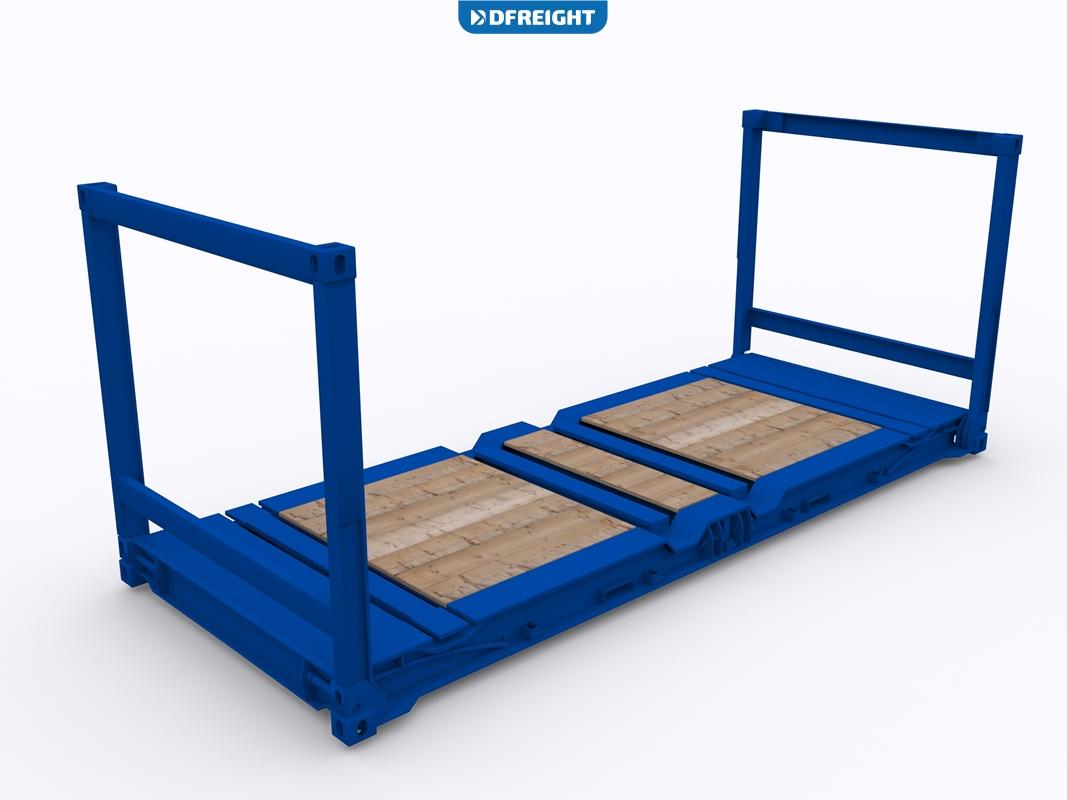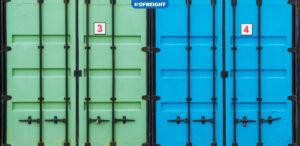When you look at shipping containers, you will most likely see a few rectangular boxes in yellow, blue, red, white, or green, but each of these containers is for a specific type of product. Despite their similar appearance, these containers serve different purposes. Educating yourself on the various types of containers will assist you in selecting the best kind of container to transport your goods. There are many different types of containers that are used for a variety of purposes. This blog post will discuss everything you need to know about flat rack containers, including their dimensions, capacity, and how to load and unload them.
Table of Contents
Flat Rack Container
Flat rack containers are an essential part of the modern supply chain. They offer a versatile and cost-effective solution for shipping everything from cars to construction materials. Flat racks are also known as platform trailers or flatbed trailers. They are designed with a flat, level surface that is perfect for hauling large or heavy loads. The sides of the flat rack are typically removable, which makes them ideal for loading and unloading with a crane or forklift. Flat racks come in various sizes and configurations, so there is sure to be a perfect option for your shipping needs.
Whether you are looking for a standard 20-foot flat rack or a custom-built 40-footer, there is a flat rack container that will fit your needs. If you are looking for a versatile and cost-effective solution for shipping, flat rack containers are the perfect option. With a variety of sizes and configurations available, there is sure to be a flat rack that will fit your needs.
Flat rack containers are typically used to transport heavy machinery, building materials, vehicles, or other over-dimensional cargo. The lack of sides and roofs on flat containers allows for easy loading and unloading of oversized freight. The most common type of flat container is a 40-foot flat rack. Flat rack containers are also available in 20′ and 30′ sizes. Flat rack containers can be transported by ship, rail, or truck. When transported by ship, containers are loaded onto the vessel using a crane. Containers transported by rail are loaded onto a rail car. Containers transported by truck are loaded onto a flatbed trailer.
The weight capacity of a flat container varies by size and type. The weight capacity of a 40′ flat container is typically between 44,000 – 66,000 lbs. The weight capacity of a 20′ flat container generally is between 22,000 – 33,000 lbs. The cargo area of a flat-rack container is commonly exposed to the elements. For this reason, flat rack containers are not widely used to transport perishable goods. Flat rack containers are an essential piece of equipment for many businesses that need to transport large, heavy, or dense items regularly. A flat-rack container is a perfect solution if your business regularly ships oversized cargo.
The Different Types of Flat Rack Containers
Flat rack containers are manufactured with either steel or aluminum and transport heavy-duty or oversized cargo that cannot be containerized. These containers have no sides and are often used to transport vehicles, machinery, or other oversized items that must be shipped overseas. Flat racks can be either open or closed. The open flat container has no roof and transports items that do not need to be protected from the elements. Closed flat racks have a roof and transport items that must be protected from the elements or sensitive to weather changes. There are two main types of flat rack containers:
Platform Containers: Platform containers have a flat surface with no sides and transport items that do not need to be containerized.
Bulk Containers: Bulk containers have sides and transport items that need to be containerized. Bulk containers are often used to transport liquids or commodities that need to be shipped in a controlled environment.
Flat rack containers are essential to the international shipping industry and transport various items worldwide. A flat rack container is perfect if you need to ship something oversized or heavy-duty. No matter what flat rack container you need, one is sure to be perfect for your needs. Take the time to compare the different types of containers to make the best decision for your business.
Specifications and Dimensions
Many types of containers are used in shipping, but flat rack containers are unique in their design and purpose. Flat racks are, as the name suggests, completely flat with no sides or roof. This container is also known as a platform container or an open-top container. Flat rack containers have no walls, so the cargo must be secured with lashings. The lashings keep the load in place and prevent it from shifting during transport. The amount and type of lashings used will depend on the cargo’s style and weight.
Flat rack containers come in two different types:
- Collapsible: These have hinged walls that can be lowered for easy loading and unloading cargo.
- Non-Collapsible: These have solid walls that can’t be lowered. The cargo must be loaded and unloaded from the top.
There are also two different types of flat rack containers based on their size:
- 20-Foot Flat Rack: These are the most common flat rack containers. They’re 20 feet long, 8 feet wide, and 8 feet tall.
- 40-Foot Flat Rack: These are twice the size of 20-foot flat racks. They’re 40 feet long, 8 feet wide, and 8 feet tall.
Flat rack containers can be made from different materials, but the most common type is steel. Steel is strong and durable, which is essential for this type of container because it needs to be able to hold a lot of weight.
The dimensions and specifications of flat rack containers can vary depending on the manufacturer. However, most flat racks will have the following dimensions and specifications:
- Length: 20 or 40 feet
- Width: 8 feet
- Height: 8 feet
- Cubic Capacity: 1,360 or 2,720 cubic feet
- Tare Weight: 4,800 or 8,000 pounds
- Maximum Gross Weight: 44,000 or 66,000 pounds
As you can see, flat rack containers are more extensive and can hold more weight than standard shipping containers. This makes them perfect for shipping heavy or oversized cargo.
How to Use Flat Rack Containers
Flat rack containers come in various sizes, but all have the same basic features: a flat surface with four sides and a bottom. There are many ways to use flat rack containers. They can be used to ship cargo that is too large or too heavy for traditional containers. They can also be used to store cargo that needs to be protected from the elements. Here are a few tips on how to use flat rack containers:
- When shipping cargo that is too large or too heavy for traditional containers, it is vital to secure the load. Flat racks have a variety of ways to secure the load, including tie-downs, nets, and straps. It is essential to use the appropriate method to secure the load, so it does not shift during transport.
- Protecting the shipment from the elements is essential when using flat rack containers to store cargo. The container should be placed in a location that is not prone to extreme temperatures or weather conditions. The container should also be placed on a level surface to prevent the cargo from shifting.
- It is also important to label the flat rack containers. The label should include the contents of the container, the destination, and the date. This will help ensure the cargo arrives at its destination safely and on time.
Flat rack containers are a versatile and convenient way to ship cargo. By following these tips, you can ensure that your shipment arrives safely and on time.
When Do You Use a Flatrack Container?
These containers are often used for shipping large, heavy, or awkward-shaped items that cannot be quickly loaded into a standard shipping container. If you are wondering when you would use a flat rack container, here are some scenarios:
- You are shipping large machinery or equipment too big or heavy to fit into a standard shipping container.
- You are shipping something very long, such as a piece of pipe or lumber.
- You are shipping something very tall, such as a stack of tires or a tall piece of machinery.
- You are shipping something very wide, such as a large piece of machinery or a stack of pallets.
- It would help if you loaded your shipment from the side rather than from the top or bottom due to its size or shape.
- You are shipping something that needs to be loaded and unloaded using a crane.
If you have a large, heavy, or awkwardly-shaped item that needs to be shipped, a flat rack container may be the right solution for you.
Safety Tips
Cargo in flat rack containers must be appropriately secured to prevent shifting during transit. Here are some tips for ensuring your load is safe:
- Use Dunnage: Properly placed dunnage will help prevent your cargo from shifting. Be sure to use an appropriate amount of dunnage for the size and weight of your shipment.
- Block and Brace: Block and brace your cargo to further prevent movement.
- Use Lashing: Lashing is securing cargo with ropes or wires. This will help keep your shipment in place and prevent damage during transit.
- Inspect regularly: Inspect your cargo regularly to ensure that it remains adequately secured.
By following these tips, you can help ensure that your cargo arrives safely at its destination.
Conclusion
Flat containers have many advantages over traditional square or rectangular containers. They are more efficient in storing and transport and take up less space. Flat containers are also easier to stack, making them ideal for warehouses and other storage facilities.
If you’re looking for a digital freight forwarder company that can provide you with faster, more efficient, and more reliable service, look no further than DFreight. We can get your shipments where they need to go quickly and without any hassle.
FAQs
How are flat rack containers different from standard shipping containers?
Flat rack containers have a flat, level floor with no sidewalls or posts, and are used to ship items that are too large or too heavy to be loaded into a standard shipping container.
Where can I get a flat rack container?
Flat rack containers can be rented or purchased from a variety of shipping companies.
How do I load a flat rack container?
Flat rack containers can be loaded from the top, side or end. They are often loaded with a crane or forklift.
How do I unload a flat rack container?
Flat rack containers can be unloaded from the top, side or end. They are often unloaded with a crane or forklift.














